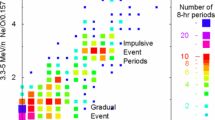Abstract
Calculated results are presented for solar radiation pressure acting on atoms and first ions. For some of these particles, radiation pressure exceeds the gravitational attraction and can accelerate them to large velocities. A comparison of the results with ionization potentials shows that the maxima of radiation pressure on neutral atoms coincide with the minima of the first ionization potentials (FIPs). This relationship is even more apparent for first ions. The minima of the second ionization potentials (SIPs) coincide with the radiation pressure maxima for a number of ions such as Be II, Mg II, Ca II, and the neighboring elements. Thus, radiation pressure may serve as a possible mechanism of acceleration of pickup ions and energetic neutral atoms (ENA) coming from an inner source (zodiacal dust and sungrazing comets). These atoms and ions, which are not typical of the solar wind, are formed as a result of the disintegration of comets or meteor showers near the Sun and can accelerate and reach the Earth’s orbit as part of the solar wind. Doubly ionized atoms have resonance lines in the UV range, where solar radiation pressure has no apparent impact on the particle dynamics; thus, the proposed acceleration mechanism can only be applied to neutral atoms and first ions with low potentials of the subsequent ionization.
Similar content being viewed by others
References
Allen, C.W., Astrophysical Quantities, Athlone Press, 1973.
Bocchialini, K. and Vial, J.-C., Solar chromospheric structures as observed simultaneously in strong UV lines. I. Observations, statistical analysis and characteristic line profiles, Astron. Astrophys., 1994, vol. 287, pp. 233–255.
Bochsler, P., Minor ions in the solar wind, Astron. Astrophys. Rev., 2007, vol. 14, pp. 1–40.
Bzowski, M. and Krolikowska, M., Are the sungrazing comets the inner source of pickup ions and energetic neutral atoms?, Astron. Astrophys., 2004, vol. 435, pp. 723–732.
Delone, A.B., Divlekeev, M.I., Sukhanov, E.A., Gulyaev, R.A., Yakunina, G.V., and Porfir’eva, G.A., The number of sodium atoms in the region of circumsolar sublimation of interplanetary dust, Astron. Rep., 2008, vol. 52, no. 2, pp. 152–156.
Giammanco, C., Wurz, P., and Karrer, R., Minor ion abundances in the slow solar wind, Astrophys. J., 2008, vol. 681, pp. 1703–1707.
Gulyaev, R.A. and Shcheglov, P.V., Emission formations in F-corona, Dokl. Akad. Nauk, 1999, vol. 366, no. 2, pp. 199–201.
Kurucz, L., Furenlid, I., Brault, J., and Testerman, L., Solar flux atlas from 296 to 1300 nm, Nat. Sol. Obs. Atlas No. 1, Harvard Univ., 1984.
Lebedinets, V.N., Aerozol’ v verkhnei atmosfere i kosmicheskaya pyl’ (Aerosol in the Upper Atmosphere and Space Dust), Leningrad: Gidrometeoizdat, 1981.
Makarova, E.A., Kharitonov, A.V., Kazachevskaya, T.V., Roshchina, E.M., and Sarychev, A.P., Observable characteristics of solar radiation (revised tables), Baltic Astron., 1998, vol. 7, pp. 467–494.
Milne, E.A., On the possibility of the emission of high-speed atoms from the Sun and stars, Mon. Notic. Roy. Astron. Soc., 1926, vol. 86, pp. 459–473.
Shestakova, L.I., Is there a region of resonance emission by atoms and ions around the Sun?, Sov. Astron. Lett., 1990, vol. 16, pp. 236–240.
Shestakova, L.I. and Tambovtseva, L.V., The thermal destruction of solids near the Sun, Earth, Moon Planets, 1997–1998, vol. 76, pp. 19–45.
Shestakova, L.I., Cometary-meteoritic gas in the Solar corona: the dynamics of Ca ions, Solar Syst. Res., 2004, vol. 38, no. 1, pp. 76–84.
Shestakova, L.I., Mechanism of atoms and ions 3D separation by means of light pressure, Izv. Nats. Akad. Nauk Resp. Kazakhstan. Ser. Fiz.-Mat., 2005, no. 4, pp. 82–86.
Shestakova, L.I., Movement of CaII ions in the inner Solar system, Astron. Astrophys. Trans., 2013, vol. 28, no. 2, pp. 109–120.
Verner, D.A., Barthel, P.D., and Tytler, D., Atomic data for absorption lines from the ground level at wavelengths greater than 228?, Preprint of Kapteyn Inst., 1994, no. 142.
Author information
Authors and Affiliations
Corresponding author
Additional information
Original Russian Text © L.I. Shestakova, 2015, published in Astronomicheskii Vestnik, 2015, Vol. 49, No. 2, pp. 148–154.
Rights and permissions
About this article
Cite this article
Shestakova, L.I. Solar radiation pressure as a mechanism of acceleration of atoms and first ions with low ionization potentials. Sol Syst Res 49, 139–145 (2015). https://doi.org/10.1134/S0038094615020057
Received:
Published:
Issue Date:
DOI: https://doi.org/10.1134/S0038094615020057




